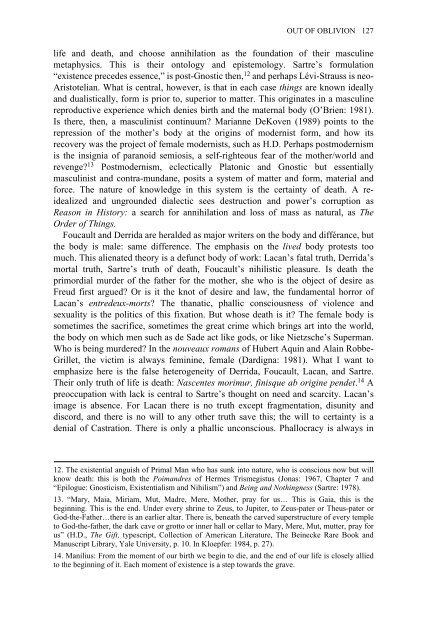Nothing Mat(t)ers: A Feminist Critique of Postmodernism
Nothing Mat(t)ers: A Feminist Critique of Postmodernism
Nothing Mat(t)ers: A Feminist Critique of Postmodernism
Create successful ePaper yourself
Turn your PDF publications into a flip-book with our unique Google optimized e-Paper software.
OUT OF OBLIVION 127<br />
life and death, and choose annihilation as the foundation <strong>of</strong> their masculine<br />
metaphysics. This is their ontology and epistemology. Sartre’s formulation<br />
“existence precedes essence,” is post-Gnostic then, 12 and perhaps Lévi-Strauss is neo-<br />
Aristotelian. What is central, however, is that in each case things are known ideally<br />
and dualistically, form is prior to, superior to matter. This originates in a masculine<br />
reproductive experience which denies birth and the maternal body (O’Brien: 1981).<br />
Is there, then, a masculinist continuum Marianne DeKoven (1989) points to the<br />
repression <strong>of</strong> the mother’s body at the origins <strong>of</strong> modernist form, and how its<br />
recovery was the project <strong>of</strong> female modernists, such as H.D. Perhaps postmodernism<br />
is the insignia <strong>of</strong> paranoid semiosis, a self-righteous fear <strong>of</strong> the mother/world and<br />
revenge 13 <strong>Postmodernism</strong>, eclectically Platonic and Gnostic but essentially<br />
masculinist and contra-mundane, posits a system <strong>of</strong> matter and form, material and<br />
force. The nature <strong>of</strong> knowledge in this system is the certainty <strong>of</strong> death. A reidealized<br />
and ungrounded dialectic sees destruction and power’s corruption as<br />
Reason in History: a search for annihilation and loss <strong>of</strong> mass as natural, as The<br />
Order <strong>of</strong> Things.<br />
Foucault and Derrida are heralded as major writ<strong>ers</strong> on the body and différance, but<br />
the body is male: same difference. The emphasis on the lived body protests too<br />
much. This alienated theory is a defunct body <strong>of</strong> work: Lacan’s fatal truth, Derrida’s<br />
mortal truth, Sartre’s truth <strong>of</strong> death, Foucault’s nihilistic pleasure. Is death the<br />
primordial murder <strong>of</strong> the father for the mother, she who is the object <strong>of</strong> desire as<br />
Freud first argued Or is it the knot <strong>of</strong> desire and law, the fundamental horror <strong>of</strong><br />
Lacan’s entredeux-morts The thanatic, phallic consciousness <strong>of</strong> violence and<br />
sexuality is the politics <strong>of</strong> this fixation. But whose death is it The female body is<br />
sometimes the sacrifice, sometimes the great crime which brings art into the world,<br />
the body on which men such as de Sade act like gods, or like Nietzsche’s Superman.<br />
Who is being murdered In the nouveaux romans <strong>of</strong> Hubert Aquin and Alain Robbe-<br />
Grillet, the victim is always feminine, female (Dardigna: 1981). What I want to<br />
emphasize here is the false heterogeneity <strong>of</strong> Derrida, Foucault, Lacan, and Sartre.<br />
Their only truth <strong>of</strong> life is death: Nascentes morimur, finisque ab origine pendet. 14 A<br />
preoccupation with lack is central to Sartre’s thought on need and scarcity. Lacan’s<br />
image is absence. For Lacan there is no truth except fragmentation, disunity and<br />
discord, and there is no will to any other truth save this; the will to certainty is a<br />
denial <strong>of</strong> Castration. There is only a phallic unconscious. Phallocracy is always in<br />
12. The existential anguish <strong>of</strong> Primal Man who has sunk into nature, who is conscious now but will<br />
know death: this is both the Poimandres <strong>of</strong> Hermes Trismegistus (Jonas: 1967, Chapter 7 and<br />
“Epilogue: Gnosticism, Existentialism and Nihilism”) and Being and <strong>Nothing</strong>ness (Sartre: 1978).<br />
13. “Mary, Maia, Miriam, Mut, Madre, Mere, Mother, pray for us… This is Gaia, this is the<br />
beginning. This is the end. Under every shrine to Zeus, to Jupiter, to Zeus-pater or Theus-pater or<br />
God-the-Father…there is an earlier altar. There is, beneath the carved sup<strong>ers</strong>tructure <strong>of</strong> every temple<br />
to God-the-father, the dark cave or grotto or inner hall or cellar to Mary, Mere, Mut, mutter, pray for<br />
us” (H.D., The Gift, typescript, Collection <strong>of</strong> American Literature, The Beinecke Rare Book and<br />
Manuscript Library, Yale Univ<strong>ers</strong>ity, p. 10. In Kloepfer: 1984, p. 27).<br />
14. Manilius: From the moment <strong>of</strong> our birth we begin to die, and the end <strong>of</strong> our life is closely allied<br />
to the beginning <strong>of</strong> it. Each moment <strong>of</strong> existence is a step towards the grave.

















